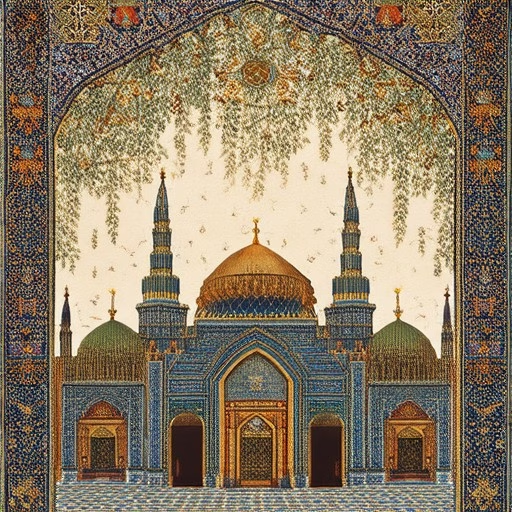Religious diversity is a cornerstone of human civilization, shaping cultures, societies, and individual identities across the globe. Understanding this multifaceted phenomenon offers insights into the complexities of human behavior, societal structures, and the interplay between belief systems. From the bustling streets of India, where multiple religions coexist harmoniously, to the dynamic religious landscapes of the United States, religious diversity underscores the resilience of humankind’s ability to cohabit and thrive in diverse faith traditions. This comprehensive exploration delves into the essence of religious diversity, examining its implications for society, education, and the workplace, while highlighting the importance of inclusivism in fostering mutual respect and understanding among differing beliefs.
Key Takeaways
- Religious Inclusivism: Affirms the validity of multiple religious traditions and one ultimate truth, focusing on shared moral and ethical principles while encouraging mutual respect and peaceful coexistence.
- Religious Pluralism: Manages diverse religious beliefs in society, promoting tolerance and cultural integration, and supports laws and educational initiatives for social harmony.
- Religious Exclusivism: Argues only one religion holds the absolute truth, marginalizing other traditions, as seen in certain interpretations of Christianity and Buddhism.

Why is it important for us to respect religious diversity?
Respecting religious diversity is crucial for fostering understanding, harmony, and cooperation in our interconnected world. Here are the key reasons why:
- Promotes Tolerance and Understanding: By respecting different religious beliefs, we create an environment where diverse perspectives are valued. This fosters tolerance and reduces misunderstandings, ultimately leading to more harmonious relationships among individuals and communities.
- Respects Individual Freedoms: Every individual has the right to express their beliefs and practices without fear of discrimination or persecution. Respecting religious diversity ensures that these freedoms are protected and upheld.
- Facilitates Personal Growth: Engaging with different cultures and beliefs broadens our perspectives and enhances empathy. This personal growth contributes to a more open-minded and compassionate worldview.
- Encourages Social Cohesion: A society that respects religious diversity is more likely to unite around common goals. This unity strengthens community bonds and promotes collective well-being.
- Supports Innovation and Productivity: Diverse groups bring varied ideas and approaches, which can drive innovation and productivity. An inclusive environment that respects all beliefs is more likely to harness this potential.
- Aligns with Ethical Principles: Respecting religious diversity aligns with moral values such as compassion, justice, and equality. It reflects our shared commitment to treating others with dignity and fairness.
In conclusion, respecting religious diversity is not just a moral obligation—it is essential for building a more inclusive, peaceful, and prosperous world. By embracing this principle, we lay the foundation for a society where everyone feels valued and respected, regardless of their beliefs.
Religious Diversity in the Workplace
Religious diversity in the workplace refers to the presence and acceptance of individuals from various religious backgrounds within an organizational setting. This diversity enriches the work environment and fosters a culture of inclusivity and mutual respect. Employers and colleagues can take active steps to create an environment that accommodates and values these differences.
Here are some examples of religious diversity in the workplace and how it can be managed effectively:
- Flexible Scheduling : Allowing employees to adjust their working hours to observe religious holidays or practices, such as Jewish Shabbat or Islamic Eid.
- Accommodation of Religious Attire : Providing options for employees to wear attire comfortable with their religious beliefs, such as hijabs for Muslim women or yarmulkes for Jewish men.
- Prayer Spaces : Designating quiet areas within the workplace where employees can engage in personal reflection or pray according to their beliefs.
- Cultural Celebrations : Organizing events to recognize and celebrate religious traditions, such as Diwali, Christmas, or Ramadan, through shared activities or decorations.
- Religious Leave Policies : Implementing policies that allow employees to take time off for religious reasons without penalty, ensuring they feel supported in their beliefs.
- Training Programs : Offering workshops or training sessions to educate employees about different religious practices and how to respectfully interact with colleagues from diverse backgrounds.
- Inclusive Policies : Creating policies that explicitly address religious diversity, such as dress codes that accommodate religious needs or guidelines for handling religious symbols in the workplace.
By implementing these practices, organizations can create a welcoming environment that respects and celebrates the rich tapestry of religious beliefs represented among their employees.
Learn more about managing religious diversity in the workplace .

Religious Diversity in the World Today
Religious diversity is a defining characteristic of modern society, reflecting the rich tapestry of cultures, traditions, and belief systems across the globe. While Christianity, Islam, Hinduism, and Buddhism remain among the most widespread religions, the world also encompasses a vast array of smaller, often lesser-known faiths and spiritual practices.
Major Religions
- Christianity : With approximately 31% of the global population, Christianity is the largest religion, comprising various denominations such as Catholicism, Protestantism, Eastern Orthodoxy, and others. Its influence is profound in cultural, social, and political spheres worldwide.
- Islam : With around 24% of the global population, Islam is the second-largest religion. It is characterized by a broad spectrum of practices and interpretations, ranging from moderate to more conservative traditions, and plays a significant role in many countries.
- Hinduism : Attracting about 15% of the global population, Hinduism is deeply rooted in India and has a complex set of deities, scriptures, and philosophical teachings that have influenced various other traditions.
- Buddhism : With roughly 7% of the global population, Buddhism emphasizes compassion, non-violence, and self-realization. It has had a lasting impact on East Asian cultures and philosophies.
Smaller and Indigenous Religions
Beyond the major religions, there are thousands of smaller faiths and traditions, including:
- Spiritual movements and New Age practices, which have gained popularity in Western societies.
- Bahá’ísm, Sikhism, and Shinto, which have significant followings in specific regions.
- Traditional indigenous religions, such as those practiced by Native American tribes, Australian Aboriginal peoples, and African tribal communities, which often blend with environmental and cultural practices.
- Modern syncretic religions, combining elements of multiple traditions to create unique spiritual frameworks.
Regional Religious Landscapes
Religious diversity varies significantly by region:
- In North America, Christianity remains dominant, but secularism and diverse faiths coexist.
- In Europe, Christianity is less predominant, and secular values are strong, alongside growing diversity due to migration.
- In Asia, Hinduism, Buddhism, and Islam hold significant sway, particularly in South Asia, Southeast Asia, and West Asia.
- Africa is marked by a mix of traditional religions, Islam, and increasingly Christianity.
- In Oceania, Indigenous religions and Christianity are prominent, with influences from Pacific Island cultures.
Challenges and Prospects
Despite its richness, religious diversity faces challenges, including:
- Conflicts arising from religious differences, often exacerbated by geopolitical tensions.
- Issues of religious freedom and persecution, particularly in regions with minority faiths.
- The rise of secularism and the decline of traditional religious adherence in some areas.
- Efforts to promote dialogue and understanding between different faiths to foster global harmony.
Understanding and appreciating religious diversity are essential for building a more inclusive and peaceful world. Each faith tradition contributes uniquely to the global tapestry, enriching our collective human experience.

Understanding Religious Inclusivism
Religious inclusivism is a theological perspective that recognizes the validity of multiple religious traditions while affirming that one ultimate truth exists. Unlike exclusivism, which claims that only one religion holds the complete truth, inclusivism allows for the possibility that other religions may contain partial truths or elements of truth.
The Core Concept
- Belief in one ultimate truth, with other religions reflecting aspects of it.
- Emphasis on common moral and ethical principles across religions.
- Recognition of shared spiritual experiences and values.
Comparative Perspective
| Religion | Inclusivism | Exclusivism | Pluralism |
|---|---|---|---|
| One True Religion | Might have elements of truth | Is the only true religion | All are equally valid |
Theological Foundations
Religious inclusivism is often rooted in interpretations of scripture and theological doctrine. For example:
- Christian Apologetics explores how Christian truths can be found within other traditions.
- Biblical Archaeology uncovers evidence supporting shared historical and cultural roots among religions.
- Hindu traditions sometimes emphasize that all major religions reflect aspects of the divine.
Practical Implications
Religious inclusivism encourages:
- Mutual respect among people of different faiths.
- Learning from other traditions to deepen one’s own understanding.
- Fostering peaceful coexistence in diverse societies.
Global Ministries Online Resources
Explore our curated articles on topics like:
- Spiritual Growth through interfaith dialogue.
- Religious Freedom and its role in society.
- Biblical Studies for deeper insight.
Religious Pluralism
Religious pluralism refers to the existence and coexistence of diverse religious beliefs, practices, and traditions within a society. It emphasizes the principle of respecting and accommodating the religious diversity found in a multicultural environment.
Key Concepts
- Tolerance: The ability to accept and respect differing opinions or beliefs, particularly in matters of religion.
- Accommodation: Creating mechanisms or policies that allow for the practice of various religions within a shared space or society.
- Cultural Integration: The process of merging different cultural and religious identities into a cohesive whole.
- Peaceful Coexistence: The state of harmonious interaction between different religious groups, characterized by mutual respect and understanding.
Significance
Religious pluralism is essential for maintaining social cohesion and preventing religious conflicts. It ensures that individuals of different faiths can coexist peacefully, contributing to a more inclusive and harmonious society.
Practical Implications
- Laws and Policies: Governments often implement laws to protect the rights of religious minorities and ensure equal treatment under the law.
- Educational Initiatives: Promoting awareness and understanding of different religious traditions through educational programs and curricula.
- Social Programs: Community-based initiatives aimed at fostering dialogue and reducing misunderstandings between different religious groups.
Global Perspectives
Religious pluralism approaches vary across different regions and cultures. Some societies may emphasize secularism, while others adopt a more inclusive approach that values religious diversity.
Challenges
- Discrimination: Issues such as religious discrimination and bias can arise, necessitating ongoing efforts to promote equality and inclusion.
- Integration Efforts: Finding ways to integrate religious practices into public life while respecting secular principles can be complex.
- Resource Competition: Managing resources and services for diverse religious needs can lead to tensions if not handled appropriately.
Conclusion
Religious pluralism is a multifaceted concept that encompasses the management and accommodation of diverse religious beliefs. By fostering tolerance, promoting cultural integration, and implementing thoughtful policies, societies can navigate the complexities of religious diversity and build a more inclusive future.

Example of Religious Exclusivism
Religious exclusivism is the belief that only one specific religion possesses the absolute truth, and all other religions are incorrect or inferior. An example of religious exclusivism can be seen in certain interpretations of Christianity, particularly in evangelical Christianity, where it is believed that salvation is only possible through faith in Jesus Christ. This perspective often leads to the view that other religions, such as Islam, Buddhism, or atheism, are unable to offer genuine salvation or spiritual fulfillment.
Another example of religious exclusivism can be observed in certain strains of Buddhism, where it is taught that only those who follow the Eightfold Path and achieve enlightenment can escape the cycle of suffering and rebirth. This belief system marginalizes other forms of spirituality or philosophical inquiry as inadequate or misguided.
These examples illustrate how religious exclusivism can manifest in various contexts, emphasizing the uniqueness and superiority of one religious tradition over others.




0 Comments